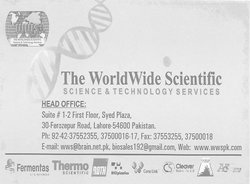Full Length Research Article
Isolation of polysaccharide producer and heavy metal tolerant local rhizobial isolates
Mohammed Hamid Jasim*, Raad Hassani Sultan
Adv. life sci., vol. 10, no. 4, pp. 657-662, December 2023
*- Corresponding Author: Mohammed Hamid Jasim (mohammed.21esp60@student.uomosul.edu.iq)
Authors' Affiliations
[Date Received: 23/07/2022; Date Revised: 12/08/2023; Date Published Online: 31/12/2023; Date Updated:09/09/2025]
Abstract![]()
Introduction
Methods
Results
Discussion
References
Abstract
Background: Rhizobia are important soil bacteria that enter into a relationship with leguminous plants and fix nitrogen symbiotically. The importance of this relation is not only for soil as a soil fertilizer but also to keep our environment without pollution.
Methods: A Survey was conducted to collect different strains of rhizobial from different areas in Nineveh Governorate in Iraq. Isolation and biochemical tests were done under laboratory conditions. Determination of exopolysaccharide and tolerance to heavy metals was also conducted. Data obtained was recorded after cultivation and incubation of rhizobial strains.
Results: The rhizobial bacteria were isolated from the following leguminous plants: Vigna unguiculata L., Trifolium alexandrinum, Trigonella foenum-graecum L., Leucaena leucocephala L., Medicago sativa L., Phaseolus vulgaris L., Tribulus terrestris L., and Vicia faba L. Maximum exopolysaccharide production was reached at 3.76 gm/L by the isolate R. leguminosarum bv. Viciae RM25, after two days of incubation. The maximum cell dry weight was 3.50 gm/L. by the isolate E. meliloti RM5, after two days of incubation. The maximum reduction in pH was 4.80 by strain E. meliloti RM14, after two days of incubation. All the local isolated rhizobia were tolerant of nickel chloride for the studied concentrations: 100, 500, 1000, and 5000 µg/ ml. Also, we were tolerant to 100 and 500 µg/ ml of zinc sulfate and copper sulfate. All rhizobial isolates also tolerated a 1000 µg/ ml concentration of zinc sulfate.
Conclusion: Rhizobium bacteria possess several mechanisms that allow them to tolerate heavy metal exposure. These mechanisms include the expression of efflux pumps, the presence of metal-resistance plasmids, the production of EPS, and the ability to adapt to environmental factors. Further research is needed to fully understand the mechanisms behind the heavy metal tolerance in Rhizobium and to explore the potential applications of these bacteria in the bioremediation of heavy metal-polluted soils.
Keywords: Rhizobium; Isolation; Exopolysaccharide production; Heavy metal tolerance
Rhizobium is a soil bacterium that forms a symbiotic relationship with leguminous plants. This relationship allows the bacteria to fix. Atmospheric nitrogen is converted into a form that can be used by the plant [1]. Heavy metal pollution is becoming increasingly common and poses a threat to the survival of many plant species. However, some strains of rhizobia have been reported to possess the ability to withstand heavy metal exposure [2, 3].
Rhizobial bacteria have been found to accumulate heavy metals such as lead and cadmium in their cells. This suggests that the bacteria can tolerate heavy metal exposure by either sequestering it in cellular compartments or by actively pumping it out of the cells. The latter mechanism involves the expression of efflux pumps that are capable of expelling heavy metals from the cell, in Rhizobium leguminosarum bv. Viciae, a metal resistance determinant, has been identified as responsible for the efflux of heavy metals [4, 5].
Several studies have reported that heavy metal tolerance in Rhizobium is associated with the presence of plasmids that carry metal-resistance genes. These genes encode proteins that are involved in metal uptake, sequestration, and detoxification. For example, a study by Lakzain et al. [6] found that a plasmid transfer among isolates of R. leguminosarum bv. Viciae in heavy metal contaminated soils. Thakur and Singh [7] revealed that the disappearance of symbiotic plasmids is a direct indicator of metal toxicity and the absence of nitrogen-fixing efficacy of the bacterial strain.
The growth stage of the bacteria also influences the ability of rhizobia to adapt to heavy metal exposure. Sazykin et al. [8] revealed that heavy metals affect the bacterial community of soils. The heavy metal tolerance in Rhizobium is also influenced by environmental factors such as pH, temperature, and oxygen availability. A study found that the pH of the growth medium had a significant impact on the metal tolerance of Rhizobium leguminosarum bv. Viciae. Also, the study found that the bacteria were more tolerant to cadmium and lead at pH 6.5 compared to pH 7.5 and 8.5. This suggests that the pH of the soil can play a role in selecting for metal-tolerant Rhizobium strains [9].
Rhizobial bacteria are known to produce exopolysaccharides (EPS) that can play a major role in metal tolerance. EPS are long chains of sugars that can bind to heavy metals and prevent them from entering the cell [10]. In addition, EPS can also act as a barrier that prevents heavy metals from binding to the cell wall and causing damage [11]. The purpose of this study is to explore the ability to isolate local rhizobial strains that can tolerate heavy metals as well as produce exopolysaccharides.
Leguminous plants collection:
Different leguminous plants, as follows: Cowpea, Clover, Fenugreek, Leucaena, Alfalfa, Green bean, Puncturevine, and Broad were collected from other farms and areas in Nineveh Governorate/Iraq. After collecting, the leguminous plant species were immediately transported to the laboratory of Microbial Molecular Biology for analysis, isolation, and characterization of the strains. The procedure of Vincent [12] was followed to isolate different bacterial isolates from root nodules of collected plants.
Nodules sampling and rhizobia isolation:
Nodules of leguminous plants were carefully detached from the root system plants and washed gently several times under tap water to remove sterile distilled water to remove soil particles. The nodule surface was sterilized by immersion in 3% NaOCl solution for a period of 2 minutes, followed by 70% ethanol for 5 minutes, and six consecutive washes in sterilized distilled water. Each sterilized surface nodule from different leguminous plants was aseptically crushed with a sterile glass rod in a test tube that contained 1 ml sterile normal saline (0.85% NaCl). One loopful of the nodule suspension was streaked on Petri dishes that contained yeast extract mannitol (YEM) agar medium with the following components (gm/mL): mannitol, 10; K2HPO4, 0.5; NaCl, 0.1; MgSO4 · 7H2O, 0.2; and agar, 16. Incubation was done for 3-4 days at 30°C. A single colony from each culture was selected and recultured on fresh YEMA plates [13]. The purified cultures were maintained on YEM agar slants and stored at 4°C in a refrigerator for further experiments.
Cultural conditions for exopolysaccharide production:
Rhizobial inoculum preparation:
The inoculum of rhizobial strains was prepared by transferring a loopful of rhizobial bacteria from tryptone yeast solid plates to a 100 ml conical flask containing 20 ml of YEM liquid medium with 6.8 pH. Incubation was done in a shaker incubator with irrigation at 150 rpm with a temperature of 28±2 ºC for 24 hrs.
Preparation for exopolysaccharide production:
Preparation of inoculates of rhizobial isolates was done by transferring a loopful of rhizobial culture growing on tryptone yeast medium to a conical flask of 100 ml with 10 ml of yeast extract mannitol broth medium. Incubation was done at 150 rpm/minute and 30°C for two days. A transfer of 2% of the inoculum to the 20 mL yeast extract mannitol broth medium was done. Conical flasks containing the inoculated medium were transferred to a shaker incubator with a temperature of 30°C and 150 rpm/minute for 2 days [14].
Determination of final pH, biomass, and exopolysaccharide, biomass:
Final pH valuation of fermented broth culture using the pH meter model PW 9421 Philips. Biomass determinations were done according to Duta et al. [15], i.e., by centrifugation of fermented rhizobial cultures by centrifuge at 6000 rpm/minute for 20 minutes. The pellet was collected and dried in an oven at 80°C for one day. Whereas for exopolysaccharide determination, the addition of 10 mL of cold ethanol to 5 mL of supernatant was done. Appropriately mixed, and the mixture was put in centrifuge tubes for centrifugation at 6000 rpm/minute for 30 minutes. Supernatant was discarded, and pellets (exopolysaccharide) were collected. Wet exopolysaccharides were dried by transfer to an oven at 80°C for 1 day. Triplicates were done for each rhizobial isolate. Biomass determinations were done by [15].
Tolerance of heavy metals:
An experiment on the tolerance of heavy metals by isolated rhizobial strains was conducted according to Teresa et al. [16]. In this procedure, wells were done on tryptone yeast extract (TY) solid medium containing the following components (g/L): tryptone, 5; yeast extract, 3; CaCl2, 0.87; and agar, 15. Petri dishes were incubated at 28±2 °C for 24 -48 hours. The tested heavy metals were as follows: Pb(CH3COO)2, ZnSO4, CuSO4, and NiCl2 with concentrations: 100, 500, 1000, and 5000 µ/mL. The diameter of the inhibition zone (clear zone) was measured in millimeters (mm) after 2 days of incubation. Isolated stains were considered resistant when no inhibition zones were observed around wells.
Screening of rhizobial isolates for exopolysaccharide production:
According to Sridevi and Mallaiah [17], the rhizobial extreme producer isolates were selected preliminarily by naked eye according to cultural appearance, i.e., mucoid culture with sticky texture.
Statistical analysis:
The values obtained in this research work were statistically analyzed for standard deviation (SD) using a computer program [18].
Isolation of local rhizobial strains:
Extreme exopolysaccharide-producing rhizobial isolates with tolerance to heavy metal salts were the goal of this study. Results revealed the success of isolation of twenty-five local rhizobial isolates from different leguminous plants. Among these isolates, eight were selected as high exopolysaccharide producers according to cultural appearance on yeast extract mannitol agar medium. The local isolates are named as follows: Ensifer fredii bv. fredii RM1, Rhizobium leguminosarum bv. trifolii RM3, Ensifer meliloti RM5, Rhizobium grahamii RM12, Ensifer meliloti RM14, Rhizobium leguminosarum bv. Phaseoli RM16, Rhizobium sp. RM23 and Rhizobium Vicia RM25. These rhizobial isolates were isolated from the following leguminous plants: Vigna unguiculata L., Trifolium alexandrinum, Trigonella foenum-graecum L., Leucaena leucocephala L., Medicago sativa L., Phaseolus vulgaris L., Tribulus terrestris L., and Vicia faba L. The leguminous plants were collected from different farms and areas in Nineveh Governorate/Iraq. Purified cultures of eight rhizobial isolates, i.e., the purified cultures produced colonies that were regular, circular, and transparent.
Production of biomass and exopolysaccharide by local isolated isolates:
Table 1 shows biomass production, as well as exopolysaccharide production and final pH. The maximum exopolysaccharide production was 3.76 gm/L by the isolate R. leguminosarum bv. Viciae RM25, and the minimum exopolysaccharide production was 0.48 gm/L by the isolate R. leguminosarum bv. trifolii RM3. Maximum dry cell weight was 3.50 gm/L by Ensifer meliloti RM5, and minimum dry cell weight was 0.21 gm/L by isolate R. grahamii RM12. Initial pH was 6.8, and after two days of incubation, it was decreased; the maximum decrease was 4.30 by the isolate Ensifer meliloti RM5. The minimum decrease in pH was by the isolate Ensifer fredii bv. Fredii, which reached 5.70. [19] found that the maximum exopolysaccharide production was 6.31 gm/ L by the isolate R. leguminosarum bv. Viciae WS18 after two days of incubation, when mannitol was used as the sole carbon source.
Other studies also revealed that the mannitol supported a maximum exopolysaccharide production [20, 21]. Ten strains of Rhizobium were isolated from Vigna mungo L. According to the research, production of exopolysaccharides is highly dependent on microorganisms, under specific conditions, media composition, as well as the genus and species of bacteria [10]. Howieson et al. [22] revealed that the decrease in fermented cultures is due to the production of acidic intermediates through incomplete oxidation of sugars in nutrient media.
Tolerance of rhizobial isolates to heavy metals:
Results of this study, Table 2 and Fig. 2-5, showed tolerance of most local isolated rhizobia to the studied heavy metals. Results revealed that all eight studied rhizobial bacteria were tolerant to nickel chloride at the studied concentrations of 100, 500, 1000, and 5000 µg/ml. Also, all the isolates were tolerant to 100 and 500 µ/ml of zinc sulfate and copper sulfate, respectively. Lead acetate at 100 µg/ml was tolerated by all isolated rhizobial strains. Tolerance of all rhizobial isolates to 1000 µg/ml of zinc sulfate was noticed. For other values, the minimum inhibition zone (4 mm) against 5000 µg/ml copper sulfate was observed by the isolate R. leguminosarum bv. Phaseoli RM16 and against 500 µg/ml lead acetate by the isolate R. leguminosarum bv. Viciae RM25 to the maximum inhibition zone (24mm) against 5000 µg/ml copper sulfate by the isolate R. leguminosarum bv. trifolii RM3. Shen et al. [23] isolated twenty rhizobial strains that showed different levels of tolerance to copper, nickel, and zinc. Liu et al. [24] results indicated novel evidence for further exploring more functional microbes from the nickel-mine soil. Rahal and Chekireb [25] analyzed the diversity of 50 strains isolated from Trifolium sp. Nodules growing on Pb-Zn mine soil. Mechanisms mediating resistance to Cobalt and Nickel have been identified in many metal-resistant rhizobia through the identification of orthologues of metal resistance genes characterized in C. metallidurans CH34 [26]. Microorganisms tolerant of metal contaminants are known to have two mechanisms by which they protect themselves from the toxic effects of heavy metals. Exclusion, as mediated by the exopolysaccharide capsule around the cell, has been shown to prevent cells’ uptake of metals [27].
Figures & Tables
Ali and Orf [10] from Egypt isolated rhizobial isolates that produced exopolysaccharide [17]. The results revealed that the ability to isolate 16 strains of Rhizobium from root nodules of Sesbania sesban grown in different areas in Indian farms, and they found that the strain SS5 was the best among the isolates in exopolysaccharide production. [19] found that the maximum exopolysaccharide production was 6.31 gm/ L by the isolate R. leguminosarum bv. Viciae WS18 after two days of incubation, when mannitol was used as the sole carbon source. Other studies also revealed that the mannitol supported a maximum exopolysaccharide production [20, 21]. Ten strains of Rhizobium were isolated from Vigna mungo L. According to the research, production of exopolysaccharides is highly dependent on microorganisms, under specific conditions, media composition, as well as the genus and species of bacteria [10, 22]. It was revealed that the decrease in fermented cultures was due to the production of acidic intermediates through incomplete oxidation of sugars in nutrient media. Shen T et al. [23] isolated twenty rhizobial strains that showed different levels of tolerance to copper, nickel, and zinc [24]. The results indicated novel evidence for further exploring more functional microbes from the nickel mine soil. [25] analyzed the diversity of 50 strains isolated from Trifolium sp. Nodules growing on Pb-Zn mine soil. Mechanisms mediating resistance to Cobalt and Nickel have been identified in many metal-resistant rhizobia through the identification of orthologs of metal resistance genes characterized in C. metallidurans CH34 [26]. Microorganisms tolerant of metal contaminants are known to have two mechanisms by which they protect themselves from the toxic effects of heavy metals. Exclusion, as mediated by the exopolysaccharide capsule around the cell, has been shown to prevent cells uptake of metals [27].
Acknowledgement
The author is grateful to the Department of Biology/ College of Education for Pure Sciences/ University of Mosul/ Mosul-Iraq, which helped to improve the quality of this work.
Author Contributions
Mohammed Jasim is a Researcher was achieved this research work under guidance of Dr. Raad Hassani Sultan.
The authors declare no conflict of interest.
- Haing T, Kyaw KN, Kyi HH, Naing KM. Isolation of rhizobia from the root nodules of cow pea & black gram cultivated in Kyaungkone, Myanmar. Journal of the Myanmar Academy of Arts and Science, (2020); 18(3): 135-143.
- Ghadbane M, Benderradji L, Medjekal S, Belhadj H, Daoud H. Plant growth promoting & heavy metal-tolerant rhizobia from Algeria. Euro-Mediterranean conference for environmental integration, (2021): pp 697-701.
- Jach ME, Sajnaga E, Ziaja M. Utilization of legume-nodule bacterial symbiosis in phytoremediation of heavy metal-contaminated soils. Biology, (2022); 11(5): 676-689.
- Lakzain A, Murphy P, Turner A, Beynon JL , Giller KE. Rhizobium leguminosarum bv. Viciae populations in soils with increasing heavy metal contamination: abundance, plasmid profiles, diversity & metal tolerance. Soil Biology & Biotechnology, (2002); 34(4): 519-529.
- 5.Rubio-Sanz L, Brito B, Palacios J. Analysis of metal tolerance in Rhizobium leguminosarum strains isolated from ultramafic soil. FEMS Microbiology Letters, (2018); 365(4): 1-7.
- Lakzain A, Murphy P, Giller K E. Transfer and loss of naturally-occurring plasmids among isolates of Rhizobium leguminosarum bv. Viciae in heavy metal contaminated soils. Soil Biology and Biochemistry, (2007): 39(5): 1066-1077.
- Thakur AK, Singh KJ. Effect of cadmium on plasmid profile of nitrogen fixing Rhizobium. Indian Journal of Plant Sciences, (2014); 4(3): 2319-3824.
- Sazykin I, Khmelevtsova L, Azhogina T, Sazykina M. Heavy metals influence on the bacterial community of soils: A review. Agriculture, (2023); 13(3): 653-676.
- Goyal RK, Habtewold JZ. Evaluation of legume-rhizobial symbiotic interactions beyond nitrogen fixation that help the host survival and diversification in hostile environments. Microorganisms, (2023); 11(6): 1454-1472.
- Ali A, Orf H O M. Screening and increase of exopolysaccharide production by rhizobial strains, stress tolerances and its efficiency with “ in vivo “ peanut plants. Egyptian Journal of Agriculture and Research, (2022); 100(1): 11-21.
- Moretto C, Castellane TCL, Leonel TF. Bioremediation of heavy metal-polluted environment by non-living cells from rhizobial isolates. Environmental Science and Pollution Research, (2022); 29(31): 46953-46967.
- Vincent JM. A Manual for the Practical Study of the Root Nodule Bacteria. I. B. P. Handbook No. 15 Oxford Black well Scientific Publications. Oxford Ltd., U. K., 1970.
- Mir MI, Kumar BK, Gopalakrishnan S. characterization of rhizobia isolated from leguminous plants and their impact on the growth of ICCV2 variety of chickpea (Cicer arietinum L.). Heliyon, (2021); 7(11): 8321-8334.
- Ghosh AC, Basu PS. Extracellular polysaccharide production by Azorhizobium caulinodans from stem nodules of leguminous emergent hydrophyte Aeschyromene aspera. Indian Journal of Experimental Biology, (2001); 39(2): 155-159.
- Duta FP, Franca FP, Lopes, LD. Optimization of culture conditions for exopolysaccharides production in Rhizobium sp. Using the response service method. Electronic Journal of Biotechnology, (2006); 9(4): 391-399.
- Teresa MS, Goma-Tchimbakala J, Eckzechel NSA. Isolation and characterization of native Rhizobium strains nodulating some legumes species in South Brazzaville in Republic of Congo.Advances in Bioscience and Biotechnology, (2021); 12(01): 10-30.
- Sridevi, M. & Mallaiah, K. V. Production of extra cellular polysaccharide by Rhizobium strains from root nodules of leguminous green manure crop, Sesbania sesban (L.) Merr. International Journal of Soil Science, (2007); 2(4): 308-313.
- SAS Institute Inc. SAS/STAT® 9.2 Users Gide, Second Edition. Cary, N. C.: SAS Institute Inc.2009.
- Qasim WS. Production of exopolysaccharide from local isolates of Rhizobium leguminosarum bv. Viciae. Mesopotomia Journal of Agriculture, (2022); 50(3): 97-107.
- Breadveld NW, Zevenhuizen LPTM, Cremers HCJC, Zehnder AJB. (1993). Influence of growth conditions on production of capsular and extracellular polysaccharides by Rhizobium leguminosarum. Antonie Van Leeuwenhoek, (1993); 64: 1-8.
- Nirmala R, Aysha OS, Valli S, Reena A, Kumar PV. Production of Extracellular polysaccharides by Rhizobium species from root nodules of Vignamungo (Hepper). International Journal of Pharmaceutical & Biological Archives, (2011); 2(4): 1209-1214.
- Howieson JG. Use of an organic buffer for the selection of acid tolerant Rhizobium meliloti strains. Plant and Soil, (1985); 88: 367-376.
- Shen T, Jin R, Yan J, Cheng X, Zeng L, et al. (2023). Study on diversity, nitrogen-fixing capacity, and heavy metal tolerance of culturable Pongamia pinnata rhizobia in the vanadium-titanium magnetite tailings. Frontiers in Microbiology, (2023): 14: 1-12.
- Liu H, Cui Y, Zhou J, Penttinen P, Liu J, et al. Nickel mine soil is a potential source for soybean plant growth promoting and heavy metal tolerant rhizobia. Peer Journal, (2022); 10: 13215-13226.
- Rahal S, Chekireb D. diversity of rhizobia and non-rhizobia endophytes isolated from root nodules of Trifolium sp. growing in lead and zinc mine site Guelma Algeria. Archives of Microbiology, (2021); 203(7): 3839-3849.
- Fagorzi C, Checcucci A, diCenzo GC, Debiec-Andrzejewska K, Dziewit L, Pini F, Mengoni A. Harnessing rhizobia to improve heavy-metal phytoremediation by legumes. Genes, (2018); 9(1): 542-558.
- El-Aziz R, Angle JS, Chaney RL. Metal tolerance of Rhizobium italic isolated from heavy-metal contaminated soils. Soil Biology and Biochemistry, (1991); 23(8): 795-798.
This work is licensed under a Creative Commons Attribution-Non Commercial 4.0 International License. To read the copy of this license please visit: https://creativecommons.org/licenses/by-nc/4.0










